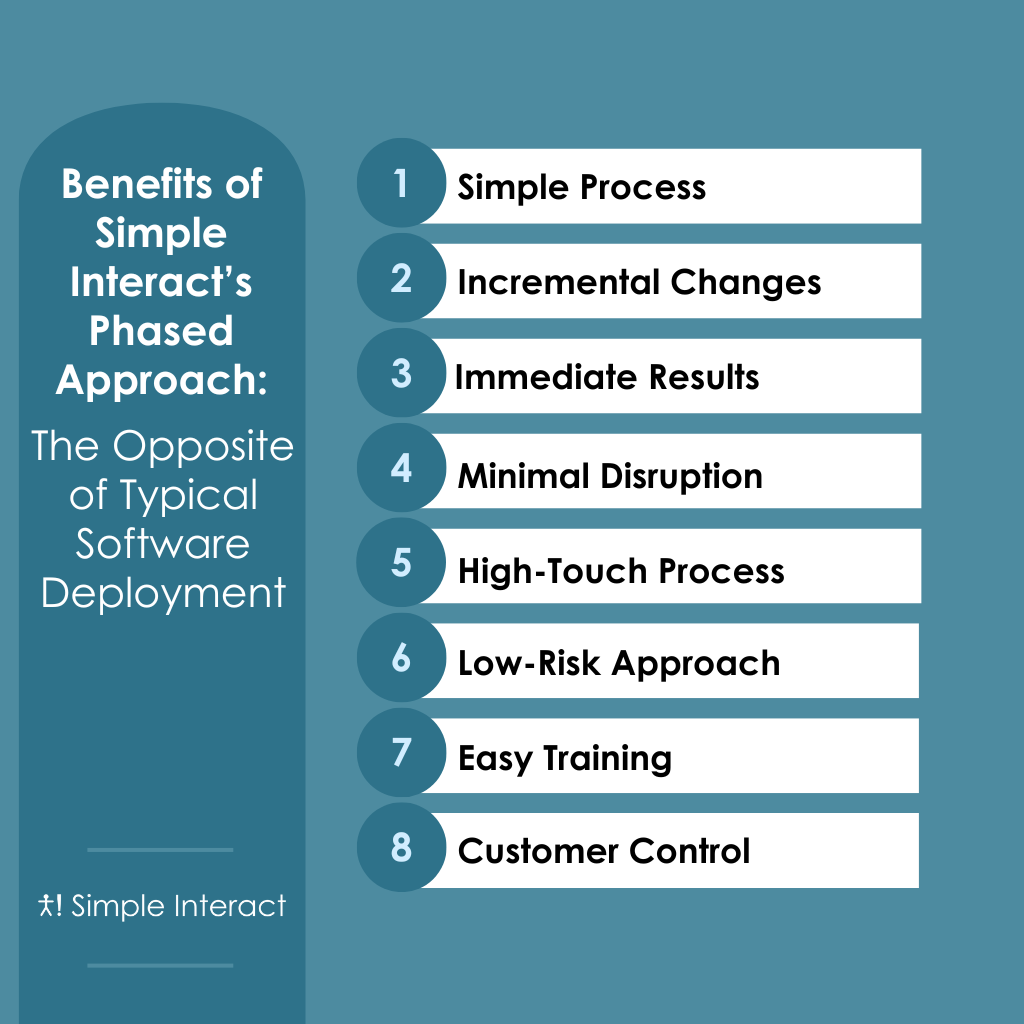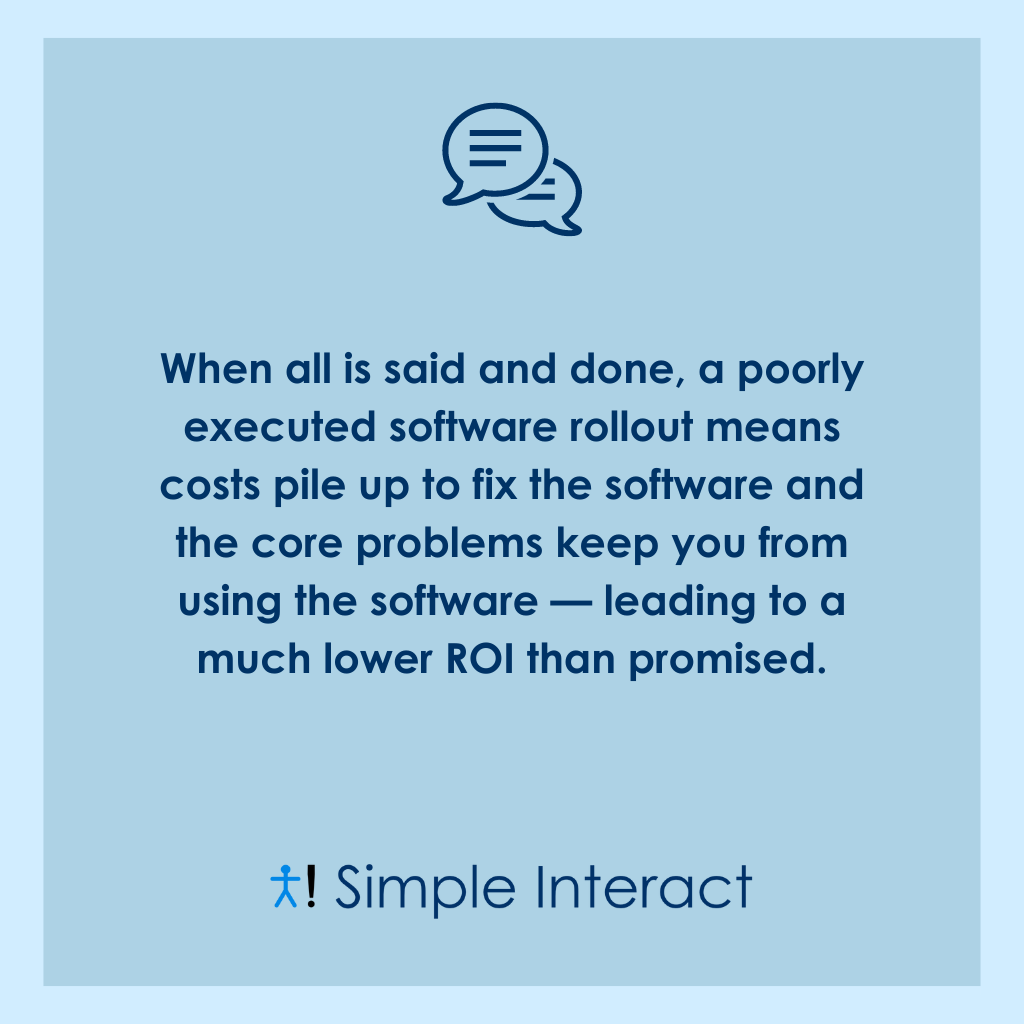How Our Phased Software Deployment Delivers Quick Results, Minimizes Disruption, and Mitigates Risk

We often work with healthcare organizations who are a little jaded from past experiences with software deployments. Chances are if you’ve ever adopted a major new software platform, you can relate.
Let’s look at what goes wrong so often in software deployments and what changes we’ve made to streamline the process.
What Commonly Goes Wrong During Software Deployment?
Tell me if this sounds familiar. You found the perfect software vendor for your unique needs, and you’re excited to start rolling it out so your healthcare organization can reap the rewards it’s supposed to deliver. But then, everything starts to go wrong, and at the end of the day, nothing is delivered as promised.
Some frustrating — and common — problems you may have run into during software deployment in the past that still give you cold feet about future software deployment may include:
- The team implementing your software didn’t understand the needs of your business because of a bad handoff from the sales team to the implementation team.
- A rollout plan needing heavy project management resulted in too many hoops to jump through and a lot of time wasted before anything was even implemented.
- When implementation finally started, there were constant delays because the company would not deploy until the entire project was complete.
- Since all the software was deployed at one time, it created a steep learning curve for your staff that required extensive and time-consuming training. Plus, when employees were learning how to use the software, it took them away from the tasks they needed to do to keep the business running.
- There was a gap between what was promised (and needed) and what was implemented, which led to staff rejection and more wasted time and delays in reworking the software to fill the gaps.
When all is said and done, a poorly executed software rollout means costs pile up to fix the software and the core problems keep you from using the software — leading to a much lower ROI than promised.

Benefits of Simple Interact’s Phased Approach: The Opposite of Typical Software Deployment
If what we just described was your experience with software deployment in the past, we understand why you’d be hesitant to try again.
However, Simple Interact doesn’t follow the typical “big bang” deployment that other software companies follow. Instead, we use a phased approach that mitigates risk with incremental changes and allows you to enjoy immediate results.
Let’s look at the benefits of our unique phased approach:
Simple Process
Our company is called Simple Interact for a reason. We’ve fine-tuned our process to keep things as simple as possible regarding patient experience, staff experience, and software deployment.
Incremental Changes
Simple Interact uses a phased rollout process of our functionality, and each step builds on the last one. This minimizes disruptions to your business and gives us several touchpoints with you to ensure we’re moving in the right direction. It also allows us to stay flexible and make changes throughout the process.
Immediate Results
Unlike with “big bang” rollouts, you can enjoy immediate results as we move through each phase of software deployment. You don’t have to wait months for the entire project to be finished before you can experience benefits from the software and begin seeing a return on investment.
For example, our customer in Example #2 below started receiving online reviews after the first phase of their rollout, which only took a few weeks from when the project started.
Minimal Disruption
Each phase of a rollout with Simple Interact includes small chunks of functionality, starting with the least disruptive changes first. Then, we slowly layer more considerable changes onto the smaller ones, so your staff can acclimate to incremental adjustments over several months instead of a massive transition all at once.
We also provide a “test mode” your staff can use in each phase to ensure they understand the platform. Once all the necessary adjustments have been made and your staff is comfortable with the functionality, we turn off the test mode. This gives you control over when changes are pushed live.
High-Touch Process
When you work with Simple Interact, you won’t be left in the dark, and you won’t go weeks or months on end without hearing from us. We stay in touch with you via weekly phone calls to keep you updated on our progress. We also use this time as an opportunity to ask clarifying questions and adjust plans as needed to ensure the success of your project.
Low-Risk Approach
Instead of a massive software deployment after several months of waiting, our incremental phased rollout allows you to see a new feature every few weeks.
This gradual test and rollout mitigates the risk of failure in achieving desired results. Even if issues are identified in a certain phase, it will be easy to course correct in a timely manner. This eliminates the possibility of waiting many months before realizing the entire software rollout was a failure.
Easy Training
The phased rollout approach for software deployment is much easier for current and future employees.
First, staff adoption will be higher since the employees will only need to learn one small change at a time instead of everything all at once. Second, since the training can be divided into small chunks, it’s easier to follow and won’t pull your staff away from the critical tasks they need to do to keep your business running.
Finally, your employees will be excited as they see new changes every few weeks, instead of impatiently waiting several months for the software deployment and being disappointed when it doesn’t work as promised.
Customer Control
When you work with Simple Interact, you’re the one in control. We ensure delivery of the functionality you need in every phase, and we won’t launch the software until we’re confident you’re completely satisfied.
Example #1: Achieving a Paperless Patient Workflow
One of our customers, an orthopedic group, used Simple Interact to boost office efficiency and patient satisfaction by improving the patient check-in process, reducing patient wait times, and minimizing time spent on paperwork.
Below, see how we approached the phased software rollout, what each phase included, and how long it took to deploy each phase:
- Phase One: Create new patient forms packet to boost patient participation (2–3 weeks). Participation reaches 50% during week 1 and climbs quickly to 90%.
- Phase Two: Create new patient forms packet for established patients, which includes the history of present illness for a new complaint (1–2 weeks).
- Phase Three: Digital check-in for established patients returning for follow-up appointments (1–2 weeks).
- Phase Four: Ad hoc forms for patients who need to sign additional informed consent forms (1–2 weeks).
- Phase Five: MIPS data capture forms to help you meet your MIPS score for healthcare processes, outcomes, and patient care experience (1–2 weeks).
Example #2: Automating Patient Engagement and Feedback
Another customer, an FQHC struggling with back-and-forth communication between patients and staff, wanted to streamline the process with Simple Interact.
We rolled out their patient engagement and feedback software in the following phases:
- Phase One: Surveys and reviews (1–2 weeks)
- Phase Two: Automated patient reminders (2–4 weeks)
- Confirmation and appointment reminders to reduce no-show patients.
- Instructions, like pre-procedure requirements and post-appointment follow-ups, and other messages, like welcome packets.
- Multi-language support for patients with different primary language preferences.
- Phase Three: Broadcast and on-demand messages (1–3 weeks)
- Standard messages, like office closures.
- Custom messages, like vaccine availability.
- Phase Four: Custom health campaigns (1–3 weeks)
- Special instructions sent to specific segments of patients based on clinical conditions, like diabetes.
- Reminders for routine health examinations and screenings based on age, gender, etc., like breast cancer or cervical cancer screening.

Experience a Successful Phased Software Rollout with Simple Interact
Above are just two of many examples of how Simple Interact’s phased deployment approach delivers quick results, minimizes disruption to your business, and mitigates risk.
If you’d like to learn more about Simple Interact to determine if our full-service front-office automation platform is right for your healthcare organization, don’t hesitate to reach out.

Ravi Kalidindi is the Founder and CEO of Simple Interact, a leading Front Office Automation company that helps healthcare facilities across the United States run more efficiently and profitably by boosting staff productivity, reducing provider burnout, and elevating the patient experience. Customers view Ravi as a trusted partner who can quickly comprehend business problems and suggest “keep it simple” solutions that are effective and easier to maintain over time.
Recent Posts
- The Benefits of Using 2-Way SMS Chat for Healthcare Communication
- 2-Way SMS vs. Live Chat: Which Is Best for Bi-Directional Patient Communication?
- Simple Interact Earns A+ Satisfaction Ratings in KLAS Report
- Boosting Healthcare Staff Productivity With a Shared Inbox Dashboard
- Healthcare SMS: What Metrics to Track in Your 2-Way SMS
Categories
Archives
- February 2025
- June 2024
- May 2024
- April 2024
- March 2024
- February 2024
- January 2024
- December 2023
- November 2023
- October 2023
- September 2023
- August 2023
- July 2023
- June 2023
- May 2023
- April 2023
- March 2023
- February 2023
- January 2023
- December 2022
- November 2022
- October 2022
- September 2022
- August 2022
- July 2021
- December 2020
- May 2020
- March 2020
- June 2016